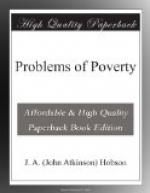of private war to the State, with the result that
as States grow stronger and better organized, the war
between them becomes fiercer and more destructive,
so is it with the concentration of capital. The
small capitalist, seeking to avoid the strain of personal
competition, amalgamates with others, and the competition
between these masses of capital waxes every day fiercer.
We have no accurate data for measuring the diminution
of the number of separate competitors which has attended
the growing concentration of capital, but we know
that the average magnitude of a successful business
is continually increasing. The following figures
illustrate the meaning of this movement from the American
cotton trade, which is not one of the industries most
susceptible to the concentrative pressure. “It
will be seen that in 756 large establishments in 1880,
in which the aggregate capital invested was five times
as great as that in the 801 establishments in 1830,
the capital invested per spindle was one-third less,
the number of spindles operated by each labourer nearly
three times as large, the product per spindle one-fourth
greater, the product per dollar invested twice as
large, the price of the cotton cloth nearly sixty
per cent, less, the consumption
per capita of
the population over one hundred per cent greater,
and the wages more than double. What is true
of this industry is true of all industries where the
concentration of capital has taken place."[38]
It is needless to add that these large works are conducted,
not by single owners, but in nearly all cases by the
managers of associated capitals. Regarded from
the large standpoint of industrial development, all
these phenomena denote a change in the sphere of competition.
From the competition of private capitals owned by
individuals we have passed to the competition of associated
capitals. The question now arises, “Will
not the same forces, which, in order to avoid the waste
and destruction of ever keener competition, compelled
the private capitalists to suspension of hostility
and to combination, act upon the larger masses of
associated capital?” The answer is already working
itself clearly out in industrial history. The
concentrative adhesive forces are everywhere driving
the competing masses of capital to seek safety, and
escape waste and destruction, by welding themselves
into still larger masses, renouncing the competition
with one another in order to compete more successfully
with other large bodies. Thus, wherever these
forces are in free operation, the number of competing
firms is continually growing less; the surviving competitors
have crushed or absorbed their weaker rivals, and
have grown big by feeding on their carcases.




